All
the |
(Navigation bar
directly below.)
*******
© A.J. Goldsby, 2015.
(All rights reserved.)
****************
Click HERE
to see my
Chess Items.
****************
****************
Buy a book
from Amazon.com
(And help me out as well!)
****************
Click HERE
...
to see a list of the businesses that help to sponsor all of
my chess efforts.

Click
HERE to return to my "Best
Players" Page.
Click HERE to return to my
"Annotated Game" Page.
Click HERE to go to my "Site
Map" Page.
(I consider this to be:)
The Most Beautiful Game of Chess Ever Played
See this same game, annotated by me ... on another website. (Go there now.)
"You Tube" Video
Monday;
October 10th, 2011: I now have a video of this game ... watch
it now!
(My YT Channel
on the YT website.)
If you enjoyed this analysis, you can download/save a free copy of it.
Note: This game and its annotations were published in an article for the Georgia State Chess Magazine in approximately 1999. I have made a few minor changes and improvements to the game since then.
I
have taught this game literally hundreds of times and I have attempted to bring
this experience to bear here. It is my hope that this is:
the finest job of annotating this game anywhere in the world!
__________________________________________________________________________
Paul Morphy (2800) -
Allies / [Count of Isouard & The Duke of
Brunswick (2200)]
[C41]
Paris (Opera Box), 1858
[A.J. Goldsby I ('99)]
(Revised again in May-June, 2002.)
Here is one of the most beautiful games ever played. Its hard to beat this games' simplicity, clarity, and energy. It is a super-brilliancy. It is a model game that has taught literally thousands of students around the world. It remains as popular a teaching vehicle today, as it was 120 years ago. Also, it is a little known fact that The Duke and The Count were two of the strongest amateur chess-players in all of Europe at that time.
Many authors, (most notably Reinfeld); have criticized Morphy's Generation as, "Too weak." This is nonsense. (In 1000 years, when humans have computer chips embedded in their brains, perhaps someone will look at Garry Kasparov's opposition and claim his opponents were too weak!! Silly.)
Professor Arpad Elo stated that you can
only judge a player by the standards of his generation!!
(See section 5.13 on page 81
of Dr. Elo's book, "The Ratings of Chess-Players,
Past &
Present.")
Quite simply, using scientific, statistical & mathematical comparisons, Morphy was easily the best player who ever lived. Just measure, "The Gap," or the distance that a player is ahead of his generation. Using this standard, Morphy was #1, Fischer was #2, and Kasparov is #3. (No others need apply!!!) (I am not the only one who thinks this. One fellow, who was nominated for for a top prize in mathematics, (The Field's Medal?); in the 1980's wrote an article concerning this subject. He too thinks Morphy was the greatest player of all time. {A.J.G.} ---> See my "Best Players" Page for more details... and some more links.) Ratings are not a totally reliable method either. Generally there has been a significant inflation in ELO ratings in the last 20 years. Most mathematicians agree it is in the neighborhood of [at least] one to two percent, (per year). If one adds this number to Bobby Fischer's best rating (2815 following his match with Petrosian), then Fischer's peak rating, after adjusting for inflation, would be 2860!! This compares very favorably to Kasparov.
Another thing to consider is that
when Bobby was 2700-plus, there was
no one
within 100 rating points
of Bobby! (circa 1972.)
[Kasparov usually has
had at least five to ten players within 100 points of his rating.]
***
Chernev writes:
"Long considered a Morphy gem, this game has far more value than as a mere brilliancy. In all the vast literature of chess, there is
NO GAME (!) which equals this one in clear, simple instruction in the basic principles. In seventeen wonderful moves we see such tactical themes as double attack, the pin, sacrifice of a Knight, Castling with a gain of tempo, adding pressure to a pin, sacrifice of the exchange, and (fortissimo) sacrifice of the Queen to force checkmate. Sprinkled throughout are moves that smite - captures or checks which greatly cut down on the choices of reply. There are strategical concepts, such as rapid development of the pieces, interference with the opposition's development, centralization, occupation of the open files, and the control of the long diagonals are all graphically demonstrated."
Chernev continues:
" No wonder (GM Frank J.) Marshall called this: 'The most famous game of all time!' "
[See {The}
"1000 Best Short Games of Chess,"
By Irving Chernev. Game # 441, page # 213.]
I will only add that it has been said one could stop the average peasant on the streets of Russia, and show them the moves of this game, and they could identify who the players were. And when I show this game at the proper point in a student's development, it seems to turn on lights on their heads.
I think a study of Morphy's games are a good first step for ANYONE - but especially a beginner - who wants to improve his tactics. Anyone who purchased a book of Morphy's games, and then subjected these games to a close and careful study, would definitely improve.
Click HERE to see this game in a java-script/(board) re-play format.
Now for the game:
1. e4, e5;
Both sides place pawns in the center of the board, in accordance with the classical principles of that time. (It was thought that this was the only correct way to play in the opening phase during that era of chess.)
Notice that both sides have controlled their respective "Queen's Five" squares, (d5 for White, and d4 for Black - also, to a lesser extent, f5 & f4). And both sides can now bring their King-Knight's out and their King's Bishops, and then castle as quickly as possible. Note too that both sides also now have an open diagonal for their respective Queen's, but normally, - unless your opponent plays an inaccurate move - you should not bring your Queen out early in the opening.
White's next move controls the center, develops a piece, readies the K-side for a possible castles, and also strongly attacks Black's e-pawn.
2. Nf3, d6;
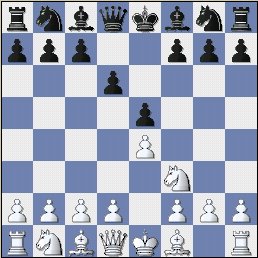
(The position after 2...d6.)
This is the Philidor's Defense. Some consider it weak. It really is not. But like any other opening, especially sharp ones, you have to study it to understand how to play it. Larsen used it effectively for a while in the late Sixties when he was in the Top Five in the world. It is not as flexible as 2...Nc6, but also has the advantage of possibly using the Black QN to support the King-side. (...Nbd7) (Note Black's KB is now shut in.)
White's next move strongly pressures Black's center.
3. d4, Bg4!?;
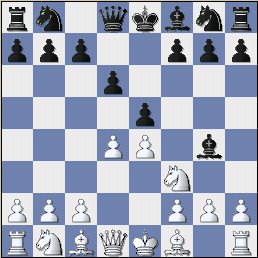
(The actual position after 3...Bg4!?)
Not the strongest move. 3...exd4; or 3...Nd7; were both better. (Or even 4...Nf6.)
(Remember Lasker said, " Knight's before Bishops!")
(This is good advice and you should follow it anytime you are unsure of what to do. However, both the Nimzo-Indian AND The Ruy Lopez openings violate this little, 'rule-of-thumb.' So the advice is NOT infallible.)
***
It should be noted here, (and
this is an important fact that has never been widely appreciated);
that
this was a standard "book" move at the time!
(The move 4...Nd7; was known but not really considered viable at the Master
level. Steinitz and Nimzovich had yet to make their impact on the chess world.)
("Book," at that time generally never went beyond moves 5-7.)
***
Black should have played 3...Nd7; or 3...Nf6; or even 3...exd4!?
***
4. dxe5, A strong move, threatening to win a pawn.
4...Bxf3; This move is now forced, to prevent the loss of the pawn.
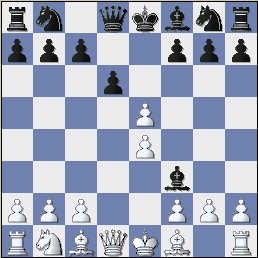
(The actual game position, after 4...Bxf3.)
5. Qxf3, ('!')
Most of the time, it is bad to bring out the Queen early. But since Black's
light-squared Bishop has already been exchanged off, (No ...Bg4 to worry
about.); the lady is quite safe here.
5...dxe5;
{Diagram?}
This is forced if Black wants to regain his pawn.
6. Bc4, ('!')
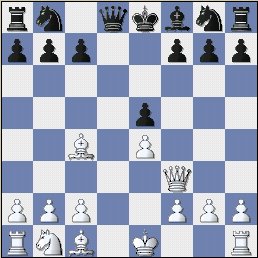
(Game position after 6. Bc4.)
A nice move. White follows all the Principles. He: A.) Controls the center; B.) Develops a piece [toward the center]; C.) Protects the King, by getting ready to Castle next move, if necessary; D.) Maintains the Material Balance; and E.) Threatens a checkmate in 1 move! I do not think you can ask for more from a move than this!!
6...Nf6;
A very natural-looking move. Black blocks the deadly attack on his f7-square and develops a piece.
Several authors have criticized this move, suggesting instead 6...Qf6. But 6...Qf6; 7.Qb3, Bc5; 8. 0-0, Bb6; 9. Nc3! still leads to a large opening advantage for White. But it is hard to foresee what White was going to play.
7. Qb3!, (Maybe even - '!!')
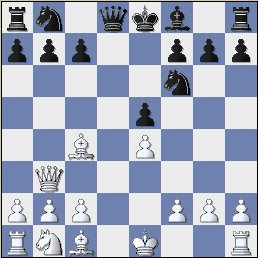
(The actual position after 7. Qb3.)
Normally it is bad to move the Queen out early, and it is doubly bad to move the same piece twice in the Opening. Here Morphy threatens a key pawn on b7 and threatens mate in two. (An example: 7...b6??; 8. Bxf7+ followed by 9. Qe6#)
The KEY to winning every chess game is tactics and DOUBLE ATTACKS!! - (GM Yuri Averbakh.)
Many (MOST) players would have probably just routinely developed with: 7. Nc3.
7...Qe7;
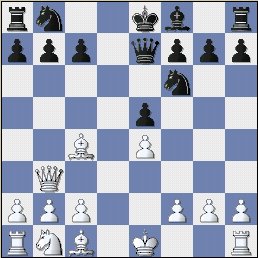
(The position after 7...Qe7;)
The only move. 7...Qd7?; loses to 8. Qxb7, Qc6; (Black is trying to save his Rook on a8.) 9. Bb5! winning the Queen. The purpose of 7...Qe7; is that Black can save his QR with a clever counter-attack. If 8. Qxb7, then Black can force the exchange of Queens with 8...Qb4+!
8. Nc3!,

(White just played the move, 8. Nc3!)
Most modern masters would play the grubby 8. QxNP/b7 and try to nurse the pawn to victory. Most computer programs today do EXACTLY this.
{The following comments were first written in 1999, and you should
bear this in mind.}
( Fritz [5.32] here wants to play the overly materialistic
8. Bxf7+,
followed by 9. Qxb7. While this wins a lot of material, it ignores
development and could subject White to a vicious counter-attack. So the
line: 8. Bxf7+, Qxf7;
9. Qxb7, Bc5; 10. Qxa8, 0-0; gives Black a huge lead in development, and a roaring
counter-attack to come. )
Morphy did not care for such pawns, like the one on b7. He knew the value of development. In fact, he was the first player to truly understand that Development in the Opening Phase is one of the basic Opening Principles. And after 8. Qxb7, then 7...Qb4+; and Black forces the exchange of Queens.
Another widely unappreciated fact is that: Most of the time, Morphy preferred to keep his Queen on the board!
8...c6; Maybe - ('!')

(Black just played 8...c6.)
An excellent move. It stops the invasion of d5 by a White Knight, and also protects the pawn on b7 laterally. It also keeps pieces off the b5 square. (Also the d5-square as well.)
9. Bg5, ('!')
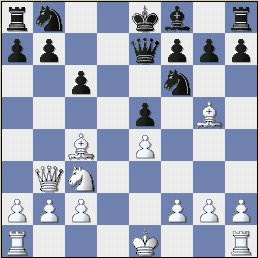
(White just played 9. Bg5.)
Its hard to resist the temptation of giving every one of Morphy's moves an exclamation mark. This is a good move, because it puts the most pressure on the Black position.
*** The Pin is a very powerful weapon! ***
9...b5!?; Maybe - '?!/?'
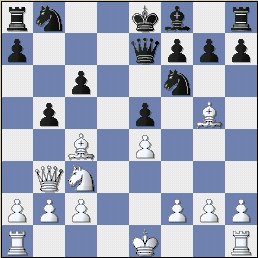
(Black just pushed his QNP forward two squares.)
It is very hard here to suggest a better move. Black's position is very difficult. 9...h6; which some authors have suggested, may have worked. (But after 9....h6; 10. Bxf6!, gxf6; [10...Qxf6??; 11. Qxb7, "+/-"] and after ...gxf6; Black majorly lags in development and has a HORRIBLE Pawn structure.) Also Petrosian once suggested 9...b6; here. Fred Reinfeld condemned this move as "weak," but failed to suggest a better alternative. (I think Pachman once suggested ...Qc7; here also, but that is not very convincing either. Certainly White will retain a clear advantage after 9...Qc7;). The advantage of this move, (9...b5;) is if White retreats, Black takes over the Initiative. The disadvantage of this move is that it invites a sacrifice. We may be eternally grateful to these players for making this move.
I might suggest the move ...a6; although this clearly weakens the dark squares on Black's Queen-side.
(In the fall of 2000 I did a test. I took this position after White's 9th move and gave it to a commercial DMP. {A dedicated micro-processor. A machine/computer that does nothing but play chess.} This machine was rated OVER 2300 USCF. After nearly half an hour, the machine picked its best move for Black and wanted to play ---> 9...b5!)
(In
2001, I repeated this test on a newer version of this same box, with the same
result!!)
(In later years I have completed this test with many strong computer {PC}
programs. {Like Fritz and ChessMaster.} They make the same error as well.)
[ Another line for Black is: 9...Qc7; 10. a4, Bc5; 11. Rd1!, 0-0; 12. Bxf6, gxf6; 13. 0-0, "+/" or "+/-". ]
***
10. Nxb5!!,
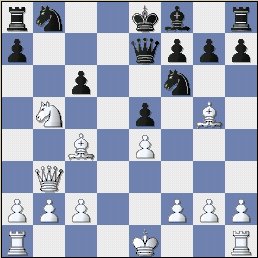
(The position after White sacks his N on b5.)
(Maybe - !!!) An extremely brilliant move. I (A.J.) have personally tested many strong players here (Including Masters!), and they have failed to play this move if unfamiliar with this game. Now Fritz 5.32 (&Fritz 6.0) considers this move best, but before the computer programs got so strong, they would think all day and never play this move. (I have used this game to test many chess computers.)
Another point to insert here. I am 100% sure that if Morphy had NOT made this sacrifice, NO ONE WOULD REMEMBER THIS GAME TODAY!
10...cxb5;
11. Bxb5+, Nbd7;
Now Black is involved in another pin on the crucial a4-e8 diagonal!! This
pin will nearly paralyze the entire Black Army for some time to come.
12. 0-0-0, Probably - ('!')
White could castle King-side, but that would not place as much pressure on the Black position. The Q-side castle immediately places pressure on the d-file.
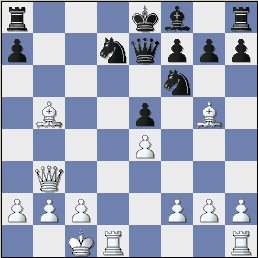
(The position after White Castles Q-side.)
An excellent move. The QR is immediately brought to bear on the position. (Putting more pressure on the PINNED Knight on d7.)
(All other moves lose the Queen or get mated.)
This is much stronger than 10. 0-0?! Also, the White King is completely safe from attack. Usually castling Q-side is inherently dangerous and leaves the Monarch slightly more exposed than when you castle with the KR.
12...Rd8[]; (Box)
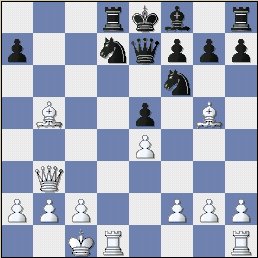
(The actual, game position after Black plays 12...Rd8.)
***
Black's
last move was forced, or the only move. Black is completely tied up.
NOTICE:
The Black King's Bishop and King's Rook play NO part in this game.
13. Rxd7!, Maybe - "!!'
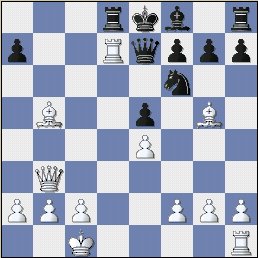
(The position after 13. Rxd7!!)
Genius, pure genius. This move shows the true beauty and calculation that Morphy concocted when he dreamt this attack up. Down material, Morphy gleefully invests a rook. The report in the newspaper the following day, (and by Edge) said Morphy played this move almost instantly.
In the early 90's, I gave this position to one of the strongest chess-playing computers then available on the market. It thought for over half an hour and still did not play the correct move.
13...Rxd7;
Now the Black Rook on d7 is the subject of, "The Absolute Pin."
(Any
pin on the King is said to be absolute. The laws of chess do not allow you to
move this piece and expose your own King to check!)
With his next move, White exerts incredible pressure on the position.
14. Rd1, Qe6;
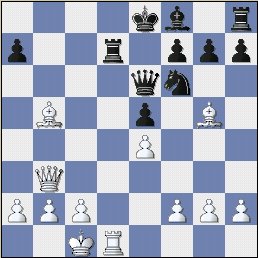
(Black just played his Queen to e6, trying to escape White's many threats.)
Black is hoping for an exchange of Queens, hoping to sap the strength of White's attack.
15. Bxd7+!, (Maybe - '!!')
A very good move, which Morphy's opponents' had NOT anticipated.
Actually, Morphy's Allied Opponents' expected something like: 15. Qxe6!?, fxe6; 16. Bxf6, gxf6; 17. Rxd7. (Now White has the threat of 18. Rxh7+, winning.) 17...Bh6; 18. Kd1, Kf8; 19. Rxa7, ("+/-") and White is winning. (This was documented in the newspapers of Paris, ... and by Edge.)
But
Morphy surprised them with his 15th move. The Count of Isouard is actually have
supposed to had to suppress a out-cry of joy,
...
believing Morphy's 15th to be a
mistake!
15...Nxd7;
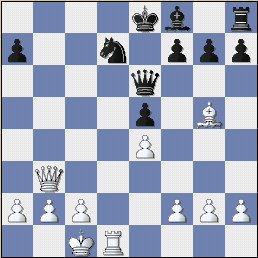
(The actual game position after Black re-captured the Bishop on d7 on his 15th move.)
Now its like mate in two. Do you see the denouement?
16. Qb8+, ('!') A complete shock to Morphy's adversaries, who were {probably} expecting the exchange of the Ladies on e6.
16...Nxb8; 17. Rd8#. (Duh!)
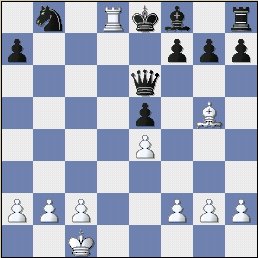
(The final position. White delivers checkmate.)
The two Black players were completely surprised by this combination. Check it out! Find another short game in all of chess where a player mates with his LAST TWO PIECES!!!
Show me just one!
( July, 2001. Several players have found games where a player sacrificed material and mated with his last two pieces. {One is Kujoth - Crittenden; Milwaukee, 1949. 1-0 in 21 moves. But this is a very ugly game by modern standards where Black plays horribly. He fails to find anywhere near the best defense.} In some of the games, the mate is obvious. Just about all the games lack the clarity and the energy of this one! Also, none of the games I have found are shorter than this game. So the economy of this game remains virtually unsurpassed, even by today's standards. Also few of the games have the appeal this one has. It is virtually perfect in nearly every regard.)
The Economy of this game alone is unsurpassed or unequaled! I consider this to be the most beautiful game ever played. (!!!) The final mating position should be especially pleasing to Problem Composers. (Its a true, perfect mate. No square is attacked more than once. There are no extra, unnecessary White pieces involved in the checkmate.)
[ Find one game, ANY game of ANY modern master, where he invests all his pieces, and then mates with the last two units/pieces on the board. ALL before move 20!!! I have never found a game that even comes close to this one. ]
***
This game remains an unparalleled MODEL game for teaching the beginner. It is also a stark warning on violating the principles and ignoring your development.
***
Again. I consider this to be the most beautiful game of chess ever played.
1 - 0
Irving
Chernev and GM Frank J. Marshall consider this, "The Most Famous Game of Chess Ever Played."
(See The book, "The Chess Companion,"
page # 233.)
*************************************************************************************************************
NEW
MATERIAL!!! Rare video footage of Bobby Fischer
analyzing this game! (Click HERE!)
(This new material posted on Thursday;
October 17th, 2013.)
Other great Morphy games
-
Tuesday; March 4th, 2014: This game ... vs. D. Harritz is as beautiful as any I have ever seen.
See this game in PGN format; OR Download it. **** This file/analysis was originally generated with ChessBase 8.0
***
This will take you to my chess downloads page. There you will find lots of goodies to download. I would have had all the files here, but for some inexplicable reason, this server {Yahoo/Geo-Cities} will NOT allow "star-dot-PGN" files to be stored here! )
Click HERE
to go to a page where you can REPLAY
this game on a java board!!!
(Right there on your computer screen.)
Click HERE now, to see THE definitive web-page on Paul Morphy!!
Did you enjoy this game?
Then
maybe you would enjoy,
"The Most Deeply Annotated Chess Game On The Internet."
(Click HERE
to go there now.)
[ See the game, Alekhine - Capablanca; 21st Match game, Buenos Aires, 1927. ]
"You Tube" Video
Monday;
October 10th, 2011: I now have a video of this game ... watch
it now!
(My YT Channel
on the YT website.)
If you enjoyed this analysis, you can download/save a free copy of it.
**********************
Click HERE to see a great web page about this game by GM G. Serper.
This
game was several years in preparation.
(This page last {majorly} updated on: Wednesday; January 19th,
2005. Last edit/save on: 01/16/2015.)
***
( I had to learn the basics of HTML and web development before I could present this game the way I really felt it deserved. )
*******
[Home] [Annotated games]
Copyright (c) A.J. Goldsby I
Copyright (©) A.J. Goldsby, 1985 - 2013.
Copyright (©) A.J. Goldsby, 2014. All rights reserved.